Selected Solutions to Complex Analysis by Lars Ahlfors
Matt Rosenzweig
1
�
Contents
Chapter 4 - Complex Integration
Cauchy’s Integral Formula . . . . . . . . . . . . . . . . . . . . . . . . . . . . . . . . . . . . . . . . .
4.2.2 Exercise 1 . . . . . . . . . . . . . . . . . . . . . . . . . . . . . . . . . . . . . . . . . . . .
4.2.3 Exercise 1 . . . . . . . . . . . . . . . . . . . . . . . . . . . . . . . . . . . . . . . . . . . .
4.2.3 Exercise 2 . . . . . . . . . . . . . . . . . . . . . . . . . . . . . . . . . . . . . . . . . . . .
Local Properties of Analytical Functions . . . . . . . . . . . . . . . . . . . . . . . . . . . . . . . . .
4.3.2 Exercise 2 . . . . . . . . . . . . . . . . . . . . . . . . . . . . . . . . . . . . . . . . . . . .
4.3.2 Exercise 4 . . . . . . . . . . . . . . . . . . . . . . . . . . . . . . . . . . . . . . . . . . . .
Calculus of Residues . . . . . . . . . . . . . . . . . . . . . . . . . . . . . . . . . . . . . . . . . . . .
4.5.2 Exercise 1 . . . . . . . . . . . . . . . . . . . . . . . . . . . . . . . . . . . . . . . . . . . .
4.5.3 Exercise 1 . . . . . . . . . . . . . . . . . . . . . . . . . . . . . . . . . . . . . . . . . . . .
4.5.3 Exercise 3 . . . . . . . . . . . . . . . . . . . . . . . . . . . . . . . . . . . . . . . . . . . .
. . . . . . . . . . . . . . . . . . . . . . . . . . . . . . . . . . . . . . . . . . . .
4.6.2 Exercise 1 . . . . . . . . . . . . . . . . . . . . . . . . . . . . . . . . . . . . . . . . . . . .
4.6.2 Exercise 2 . . . . . . . . . . . . . . . . . . . . . . . . . . . . . . . . . . . . . . . . . . . .
4.6.4 Exercise 1 . . . . . . . . . . . . . . . . . . . . . . . . . . . . . . . . . . . . . . . . . . . .
4.6.4 Exercise 5 . . . . . . . . . . . . . . . . . . . . . . . . . . . . . . . . . . . . . . . . . . . .
4.6.4 Exercise 6 . . . . . . . . . . . . . . . . . . . . . . . . . . . . . . . . . . . . . . . . . . . .
4.6.5 Exercise 1 . . . . . . . . . . . . . . . . . . . . . . . . . . . . . . . . . . . . . . . . . . . .
4.6.5 Exercise 3 . . . . . . . . . . . . . . . . . . . . . . . . . . . . . . . . . . . . . . . . . . . .
Harmonic Functions
Chapter 5 - Series and Product Developments
Power Series Expansions . . . . . . . . . . . . . . . . . . . . . . . . . . . . . . . . . . . . . . . . . .
5.1.1 Exercise 2 . . . . . . . . . . . . . . . . . . . . . . . . . . . . . . . . . . . . . . . . . . . .
5.1.2 Exercise 2 . . . . . . . . . . . . . . . . . . . . . . . . . . . . . . . . . . . . . . . . . . . .
5.1.2 Exercise 3 . . . . . . . . . . . . . . . . . . . . . . . . . . . . . . . . . . . . . . . . . . . .
Partial Fractions and Factorization . . . . . . . . . . . . . . . . . . . . . . . . . . . . . . . . . . . .
5.2.1 Exercise 1 . . . . . . . . . . . . . . . . . . . . . . . . . . . . . . . . . . . . . . . . . . . .
5.2.1 Exercise 2 . . . . . . . . . . . . . . . . . . . . . . . . . . . . . . . . . . . . . . . . . . . .
5.2.2 Exercise 2 . . . . . . . . . . . . . . . . . . . . . . . . . . . . . . . . . . . . . . . . . . . .
5.2.3 Exercise 3 . . . . . . . . . . . . . . . . . . . . . . . . . . . . . . . . . . . . . . . . . . . .
5.2.3 Exercise 4 . . . . . . . . . . . . . . . . . . . . . . . . . . . . . . . . . . . . . . . . . . . .
5.2.4 Exercise 2 . . . . . . . . . . . . . . . . . . . . . . . . . . . . . . . . . . . . . . . . . . . .
5.2.4 Exercise 3 . . . . . . . . . . . . . . . . . . . . . . . . . . . . . . . . . . . . . . . . . . . .
5.2.5 Exercise 2 . . . . . . . . . . . . . . . . . . . . . . . . . . . . . . . . . . . . . . . . . . . .
5.2.5 Exercise 3 . . . . . . . . . . . . . . . . . . . . . . . . . . . . . . . . . . . . . . . . . . . .
. . . . . . . . . . . . . . . . . . . . . . . . . . . . . . . . . . . . . . . . . . . . . .
5.3.2 Exercise 1 . . . . . . . . . . . . . . . . . . . . . . . . . . . . . . . . . . . . . . . . . . . .
5.3.2 Exercise 2 . . . . . . . . . . . . . . . . . . . . . . . . . . . . . . . . . . . . . . . . . . . .
5.5.5 Exercise 1 . . . . . . . . . . . . . . . . . . . . . . . . . . . . . . . . . . . . . . . . . . . .
. . . . . . . . . . . . . . . . . . . . . . . . . . . . . . . . . . . . . . . . . . . . . .
5.5.5 Exercise 3 . . . . . . . . . . . . . . . . . . . . . . . . . . . . . . . . . . . . . . . . . . . .
5.5.5 Exercise 4 . . . . . . . . . . . . . . . . . . . . . . . . . . . . . . . . . . . . . . . . . . . .
Entire Functions
Normal Families
4
4
4
4
5
6
6
6
7
7
7
8
10
10
10
11
12
13
13
13
14
14
14
15
16
16
16
17
18
18
19
19
20
20
21
22
22
23
23
24
24
25
2
�
Conformal Mapping, Dirichlet’s Problem
The Riemann Mapping Theorem . . . . . . . . . . . . . . . . . . . . . . . . . . . . . . . . . . . . .
6.1.1 Exercise 1 . . . . . . . . . . . . . . . . . . . . . . . . . . . . . . . . . . . . . . . . . . . .
6.1.1 Exercise 2 . . . . . . . . . . . . . . . . . . . . . . . . . . . . . . . . . . . . . . . . . . . .
Elliptic Functions
Weierstrass Theory . . . . . . . . . . . . . . . . . . . . . . . . . . . . . . . . . . . . . . . . . . . . .
7.3.2 Exercise 2 . . . . . . . . . . . . . . . . . . . . . . . . . . . . . . . . . . . . . . . . . . . .
7.3.3 Exercise 1 . . . . . . . . . . . . . . . . . . . . . . . . . . . . . . . . . . . . . . . . . . . .
7.3.3 Exercise 2 . . . . . . . . . . . . . . . . . . . . . . . . . . . . . . . . . . . . . . . . . . . .
7.3.3 Exercise 3 . . . . . . . . . . . . . . . . . . . . . . . . . . . . . . . . . . . . . . . . . . . .
7.3.3 Exercise 4 . . . . . . . . . . . . . . . . . . . . . . . . . . . . . . . . . . . . . . . . . . . .
7.3.3 Exercise 5 . . . . . . . . . . . . . . . . . . . . . . . . . . . . . . . . . . . . . . . . . . . .
7.3.3 Exercise 7 . . . . . . . . . . . . . . . . . . . . . . . . . . . . . . . . . . . . . . . . . . . .
7.3.5 Exercise 1 . . . . . . . . . . . . . . . . . . . . . . . . . . . . . . . . . . . . . . . . . . . .
27
27
27
27
28
28
29
29
30
30
31
31
32
32
3
�
Chapter 4 - Complex Integration
Cauchy’s Integral Formula
4.2.2 Exercise 1
Applying the Cauchy integral formula to f (z) = ez,
|z|=1
ez
z
dz
dz ⇐⇒ 2πi =
1 = f (0) =
1
2πi
f (z)
|z|=1
z
Section 4.2.2 Exercise 2
Using partial fractions, we may express the integrand as
1
z2 + 1
=
i
2(z + i)
−
i
2(z − i)
Applying the Cauchy integral formula to the constant function f (z) = 1,
1
1
1
2πi
1
dz =
i
2
|z|=2
z2 + 1
2πi
|z|=2
z + i
2πi
|z|=2
1
dz − i
2
1
z − i
dz = 0
4.2.3 Exercise 1
1. Applying Cauchy’s differentiation formula to f (z) = ez,
1 = f (n−1)(0) =
(n − 1)!
2πi
|z|=1
ez
zn dz ⇐⇒ 2πi
(n − 1)!
=
|z|=1
ez
zn dz
2. We consider the following cases:
(a) If n ≥ 0, m ≥ 0, then it is obvious from the analyticity of zn(1 − z)m and Cauchy’s theorem that
the integral is 0.
(b) If n ≥ 0, m < 0, then by the Cauchy differentiation formula,
|z|=2
zn(1−z)mdz = (−1)m
0
(−1)m2πi
(|m|−1)!
(c) If n < 0, m ≥ 0, then by a completely analogous argument,
(z − 1)|m| dz =
|z|=2
zn
zn(1−z)mdz =
(1 − z)m
z|n|
dz =
|z|=2
0
(−1)|n|−12πi
(|n|−1)!
n ≥ |m|
n < |m| − 1
n!
(n−|m|+1)! = (−1)|m|2πi n|m|−1
(m−|n|+1)! = (−1)|n|−12πi m|n|−1
m!
m < |n| − 1
m ≥ n
(d) If n < 0, m < 0, then sincen(|z| = 2, 0) = n(|z| = 2, 1) = 1, we have by the residue formula that
|z|=2
|z|=2
(1 − z)mzn = 2πires(f ; 0) + 2πires(f ; 1) =
4
(1 − z)mzndz +
(1 − z)mzndz
|z|= 1
2
|z−1|= 1
2
�
Using Cauchy’s differentiation formula, we obtain
(1 − z)−|m|
z−|n|
(1 − z)mzndz =
2
=
2πi
dz +
|z|=2
z|n|
|z|= 1
· (|m| + |n| − 2)!
|m| + |n| − 2
(|m| − 1)!
3. If ρ = 0, then it is trivial that
1
|z|=ρ |z − a|−4 |dz| = 0, so assume otherwise. If a = 0, then
|m| + |n| − 2
(1 − z)|m| dz
· (−1)|m|−1(|n| + |m| − 2)!
(−1)|m|2πi
(|m| − 1)!
(|n| − 1)!
(|n| − 1)!
|n| − 1
|n| − 1
|z−1|= 1
= 2πi
= 0
−
+
2
|z|−4 |dz| =
ρ−42πiρdt =
2πi
ρ3
0
|z|=ρ
Now, assume that a = 0. Observe that
|z − a|−4 |dz| =
|z|=ρ
|z|=ρ
1
1
(z − a)2(z − a)2 |dz| =
(ρe2πit − a)2(ρe−2πit − a)2 ρ
2πie4πit
ie4πit dt
1
|z − a|4 =
(z − a)2(z − a)
2
1
1
0
−i
ρ
1
−iρ
a2
0
ρ2πie4πit
(ρe2πit − a)2(ρ − ae2πit)2 dt =
= −i
dz
a )2(z − a)2
We consider two cases. First, suppose |a| > ρ. Then z(z − a)−2 is holomorphic on and inside {|z| = ρ}
and ρ2
a lies inside {|z| = ρ}. By Cauchy’s differentiation formula,
ρ z)2(z − a)2
(z − ρ2
(ρ − a
(z − a)−2 − 2z(z − a)−3
|z − a|−4 |dz| = 2πi
1 − 2
|z|=ρ
|z|=ρ
dz =
2πρ
=
z
z
z= ρ2
a
a2( ρ2
a − a)2
ρ2
a − a)
a( ρ2
−iρ
a2
−2πρ(ρ2 + |a|2)
(ρ2 − |a|2)3
=
=
2πρ(ρ2 + |a|2)
(|a|2 − ρ2)3
|z|=ρ
|z|=ρ
Now, suppose |a| < ρ. Then ρ2
inside {|z| = ρ}. By Cauchy’s differentiation formula,
a lies outside |z| = ρ, so the function z(z − ρ2
|z − a|−4 |dz| = 2πi
−iρ
a2
−2πρ
=
(|a|2 − ρ2)2
a )−2 is holomorphic on and
1 − 2
a
(a − ρ2
a )
(z − ρ2
a
)−2 − 2z(z − ρ2
a
)−3
z=a
(a + ρ2
a )
a − ρ2
a
=
−2πρ(|a|2 + ρ2)
(|a|2 − ρ2)3
=
=
2πρ
a2(a − ρ2
a )2
2πρ(|a|2 + ρ2)
(ρ2 − |a|2)3
4.2.3 Exercise 2
Let f : C → C be a holomorphic function satisfying the following condition: there exists R > 0 and n ∈ N
such that |f (z)| < |z|n ∀|z| ≥ R. For every r ≥ R, we have by the Cauchy differentiation formula that for
all m > n,
f (m)(a)
≤ m!
2π
|z|n
|z|m+1 |dz| ≤ m!
rm−n
|z|=r
Noting that m − n ≥ 1 and letting r → ∞, we have that f (m)(a) = 0. Since f is entire, for every a ∈ C, we
may write
f (z) = f (a) + f(a)(z − a) + ··· +
(z − a)n + fn+1(z)(z − a)n+1 ∀z ∈ C
f (n)(a)
n!
where fn+1 is entire. Since fn+1(a) = f (n+1)(a) = 0 and a ∈ C was arbitary, we have that fn+1 ≡ 0 on C.
Hence, f is a polynomial of degree at most n.
5
�
+
cn−2
h(0)
1!
g(z) − cn−1
z→∞ g(z) − cn−1
lim
z→0
zn−1 +
Local Properties of Analytical Functions
4.3.2 Exercise 2
Let f : C → C be an entire function with a nonessential singularity at ∞. Consider the function g(z) = f 1
at z = 0. Let n ∈ N be minimal such that limz→0 zng(z) = 0. Then the function zn−1g(z) has an analytic
continuation h(z) defined on all of C. By Taylor’s theorem, we may express h(z) as
z
zn−1g(z) = h(z) = h(0)
cn−1
h(0)
2!
z2 + ··· +
h(n−1)(0)
(n − 1)!
z +
c0
zn−1 + hn(z)zn ∀z = 0
where hn : C → C is holomorphic. Hence,
= lim
z→0
zhn(z) = 0
cn−2
zn−2 + ··· + c0
cn−2
zn−2 + ··· + c0
And
since f is entire. Note that we also obtain that c0 = f (0). Hence, g(z) − cn−1
zn−1 +
f (z) = f (0)
= lim
z→0
lim
are abusing notation to denote the continuation to all of C) is a bounded entire function and is therefore
identically zero by Liouville’s theorem. Hence,
zn−1 + cn−2
zn−2 + ··· + c0
(we
∀z = 0, f (z) = cn−1zn−1 + cn−2zn−2 + ··· + c0
Since f (0) = c0, we obtain that f is a polynomial.
k=1 of C. By definition, the function ˜f (z) = f 1
has either a removable singularity or a pole at z = 0.
4.3.2 Exercise 4
Let f : C ∪ {∞} → C ∪ {∞} be a meromorphic function in the extended complex plane. First, I claim that
f has finitely many poles. Since the poles of f are isolated points, they form an at most countable subset
{pk}∞
In either case, there exists r > 0 such that ˜f is holomorphic on D(0; r). Hence, {pk}∞
k=1 ⊂ D(0; r). Since
this set is bounded, {pk}∞
k=1 has a limit point p. By continuity, f (p) = ∞ and therefore p is a pole. Since p
is an isolated point, there must exist N ∈ N such that ∀k ≥ N, pk = p.
Our reasoning in the preceding Exercise 2 shows that for any pole pk = ∞ of order mk, we can write in a
neighborhood of pk
(z − pk)mk−1 + ··· +
(z − pk)mk
c1
z − pk
cmk−1
+gk(z)
f (z) =
+ c0
cmk
+
z
and
cm∞
fk(z)
where gk is holomorphic in a neighborhood of pk. If p = ∞ is a pole, then analogously,
c1
z
+ c0
˜f∞(z)
˜f (z) =
+˜g∞(z)
zm∞ +
where ˜g∞ is holomorphic in a neighborhood of 0. For clarification, the coefficients cn depend on the pole,
cm∞−1
zm∞−1 + ··· +
but we omit the dependence for convenience. Set f∞(z) = ˜f∞ 1
h(z) = f (z) − f∞(z) − n
i=k fk(z) and in a neighborhood of z∞ as h(z) = g∞(z) −n
− f∞ 1
h can be written as h(z) = gk(z) −
which are sums of holomorphic functions. ˜h(z) = h 1
are polynomials and f 1
is evidently bounded in a neighborhood of 0 since
= ˜g∞(z), which is holomorphic in a neighborhood of 0. By
I claim that h is (or rather, extends to) an entire, bounded function. Indeed, in a neighborhood of each zk,
k=1 fk(z),
the fk
Liouville’s theorem, h is a constant. It is immediate from the definition of h that f is a rational function.
1
fk(z)
k=1
z
z
z
z
z
6
�
Calculus of Residues
4.5.2 Exercise 1
Set f (z) = 6z3 and g(z) = z7 − 2z5 − z + 1. Clearly, f, g are entire, |f (z)| > |g(z)| ∀|z| = 1, and
f (z) + g(z) = z7 − 2z5 + 6z3 − z + 1. By Rouch´e’s theorem, f and f + g have the same number of zeros,
which is 3 (counted with order), in the disk {|z| < 1}.
Section 4.5.2 Exercise 2
Set f (z) = z4 and g(z) = −6z + 3. Clearly, f, g are entire, |f (z)| > |g(z)| ∀|z| = 2. By Rouch´e’s theorem,
z4−6z +3 has 4 roots (counted with order) in the open disk {|z| < 2}. Now set f (z) = −6z and g(z) = z4 +3.
Clearly, |f (z)| > |g(z)| ∀|z| = 1. By Rouch´e’s theorem, z4 − 6z + 3 = 0 has 1 root in the in the open disk
{|z| < 1}. Observe that if z ∈ {1 ≤ |z| < 2} is root, then by the reverse triangle inequality,
3 = |z|z3 − 6 ≥ |z||z|3 − 6
So |z| ∈ (1, 2). Hence, the equation z4 − 6z + 3 = 0 has 3 roots (counted with order) with modulus strictly
between 1 and 2.
4.5.3 Exercise 1
1. Set f (z) =
1
z2+5z+6 =
2. Set f (z) =
1
(z2−1)2 =
(z+3)(z+2) . Then f has poles z1 = −2, z2 = −3 and by Cauchy integral formula,
1
res(f ; z1) =
res(f ; z2) =
1
2πi
1
2πi
|z+2|= 1
2
|z+3|= 1
2
(z + 3)−1
(z + 2)
(z + 2)−1
(z + 3)
dz =
1
z + 3
|z=−2 = 1
dz =
1
z + 2
|z=−3 − 1
(z−1)2(z+1)2 . Then f has poles z1 = −1, z2 = −1. Applying Cauchy’s differentia-
1
tion formula, we obtain
res(f ; z1) =
res(f ; z2) =
1
2πi
1
2πi
(z − 1)−2
(z + 1)2 dz = −2(z − 1)−3|z=−1 =
(z + 1)−2
(z − 1)2 dz = −2(z + 1)−3|z=1 = − 1
1
4
4
|z+1|=1
|z−1|=1
3. sin(z) has zeros at kπ, k ∈ Z, hence sin(z)−1 has poles at zk = kπ. We can write sin(z) = (z −
zk) [cos(zk) + gk(z)], where gk is holomorphic and gk(zk) = 0. By the Cauchy integral formula,
res(f ; zk) =
1
2πi
|z−zk|=1
[f(zk) + gk(z)]
−1
(z − zk)
dz =
1
f(zk) + g(zk)
= (−1)k
4. Set f (z) = cot(z). Since sin(z) has zeros at zk = kπ, k ∈ Z and cos(zk) = 0, cot(z) has poles at
zk, k ∈ Z. We can write sin(z) = (z − zk) [cos(zk) + gk(z)], where gk is holomorphic and gk(zk) = 0.
By Cauchy’s integral formula,
res(f ; zk) =
1
2πi
|z−zk|=1
cos(z) [cos(zk) + gk(z)]
(z − zk)
−1
dz =
cos(zk)
cos(zk) + gk(zk)
= 1
5. It follows from (3) that f (z) = sin(z)−2 has poles at zk = kπ, k ∈ Z. We remark further that
gk(z) = − cos(zk)(z − zk)2 + hk(z), where hk(z) is holomorphic. By the Cauchy differentiation formula,
res(f ; zk) =
1
2πi
|z−zk|=1
−2
[cos(zk) + gk(z)]
(z − zk)2
dz = −2
g
k(zk)
(cos(zk) + gk(zk))3 = 0
7
�
6. Evidently, the poles of f (z) =
zm(1−z)n are z1 = 0, z2 = 1. By Cauchy’s differentiation formula,
1
1
2πi
res(f ; z1) =
(1 − z)−n
dz =
(n + m − 2)!
(n − 1)!(m − 1)!
=
|z|= 1
2
zm
res(f ; z2) =
(−1)n
2πi
z−m
(z − 1)n dz =
|z−1|= 1
2
(−1)n(−1)n−1(m + n − 2)!
(m − 1)!
n + m − 2
n + m − 2
m − 1
= −
n − 1
4.5.3 Exercise 3
(a) Since a + sin2(θ) = a + 1−cos(2θ)
= 2 [(2a + 1) − cos(2θ)], we have
π
2
2
π
2
dθ
dθ
0
0
= 2
(2a + 1) − cos(2θ)
a + sin2(θ)
π
the integrand. Ahlfors p. 155 computes π
=
0
π
0
dτ
=
dt
(2a + 1) − cos(t)
=
0
dτ
−π
(2a + 1) + cos(τ )
where we make the change of variable τ = θ − π, and the last equality follows from the symmetry of
(2a + 1) + cos(τ )
π
2
dx
α+cos(x) = π√
α2−1
0
for α > 1. Hence,
dθ
a + sin2(θ)
0
(2a + 1)2 − 1
π
=
(b) Set
f (z) =
For R >> 0,
z4 + 5z2 + 6
z2
z2
=
(z2 + 3)(z2 + 2)
3i)(z − √
γ1 : [−R, R] → C, γ1(t) = t; γ2 : [0, π] → C, γ2(t) = Reit
(z − √
3i)(z +
√
=
z2
√
2i)
2i)(z +
and let γ be the positively oriented closed curve formed by γ1, γ2. By the residue formula and applying
the Cauchy integral formula to eiz
z+ai to compute res(f ; ai),
γ
f (z)dz = 2πires(f ;
3i) + 2πires(f ;
√
√
2i)
It is immediate from Cauchy’s integral formula that
√
2πires(f ;
3i) =
√
2i) =
2πires(f ;
3)−1(z2 + 2)−1
√
z2(z + i
√
(z − i
√
2)−1(z2 + 3)−1
√
(z − i
3)
2)
z2(z + i
|z−i
√
3|=�
|z−i
√
2|=�
√
(i
dz = 2πi ·
√
((i
3)2
√
3)2 + 2)(2i
√
3π
=
3)
dz = 2πi ·
√
((i
√
(i
2)2
2)2 + 3)(2i
√
= −
2π
√
2)
Using the reverse triangle inequality, we obtain the estimate
≤
∞
γ2
f (z)dz
x2
Hence,
∞
2
x2
=
x4 + 5x2 + 6
0
−∞
x4 + 5x2 + 6
πR3
|R2 − 3||R2 − 2| → 0, R → ∞
√
dx = (
3 −
√
2)π ⇒
∞
x2dx
x4 + 5x2 + 6
0
√
3 − √
(
2)π
2
=
8
�
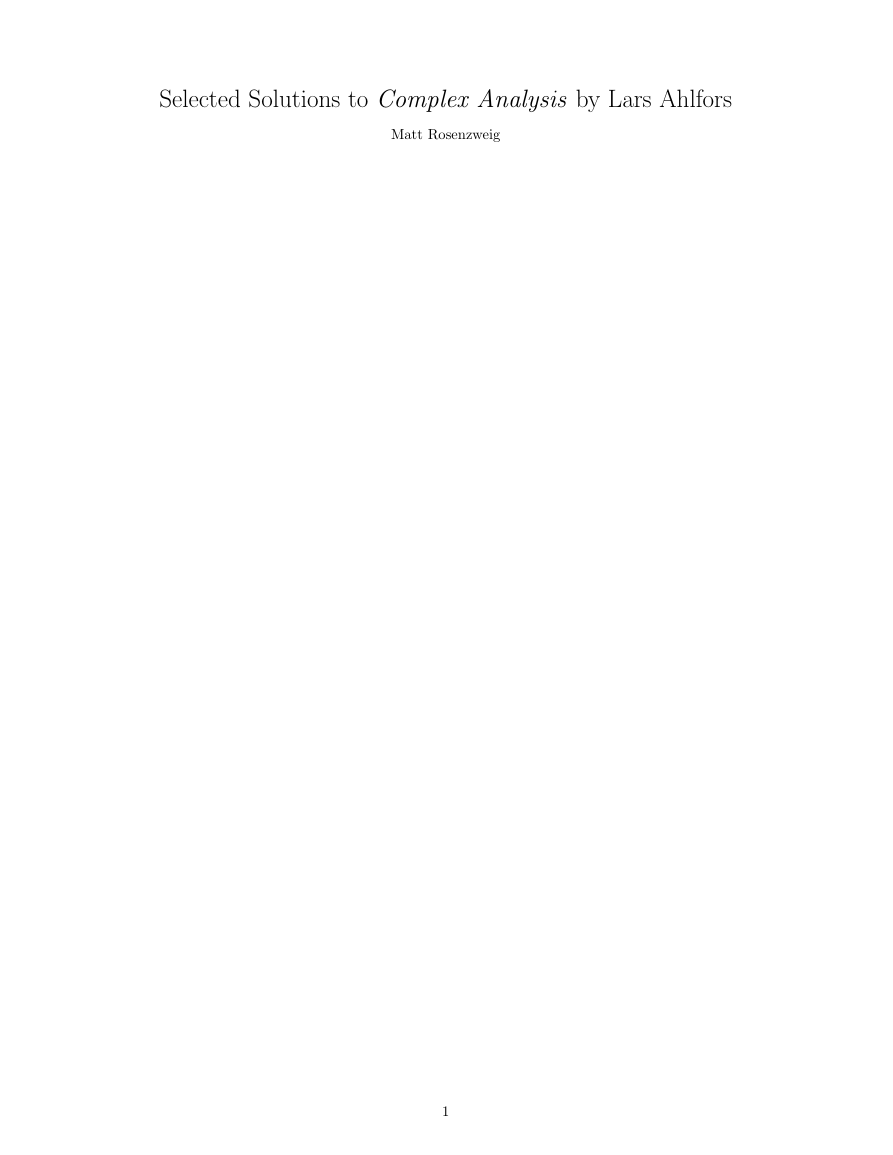
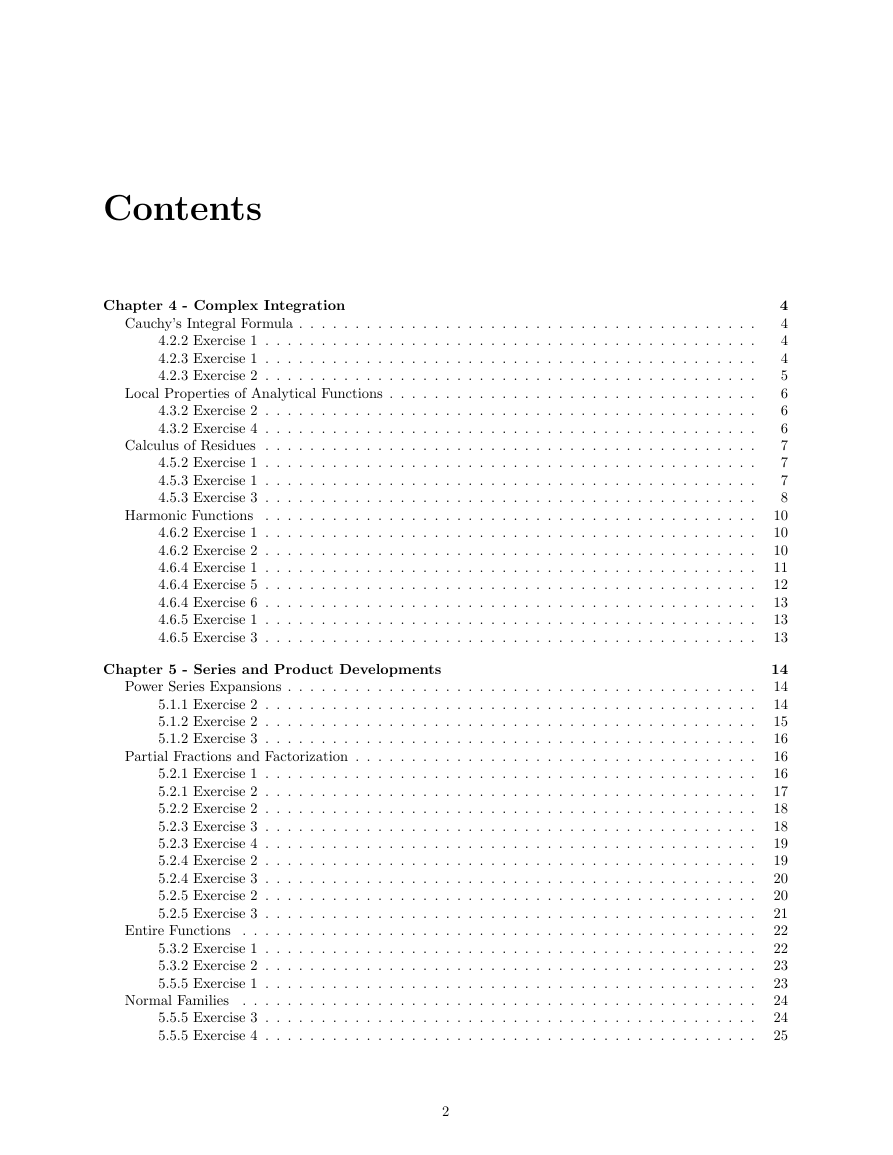
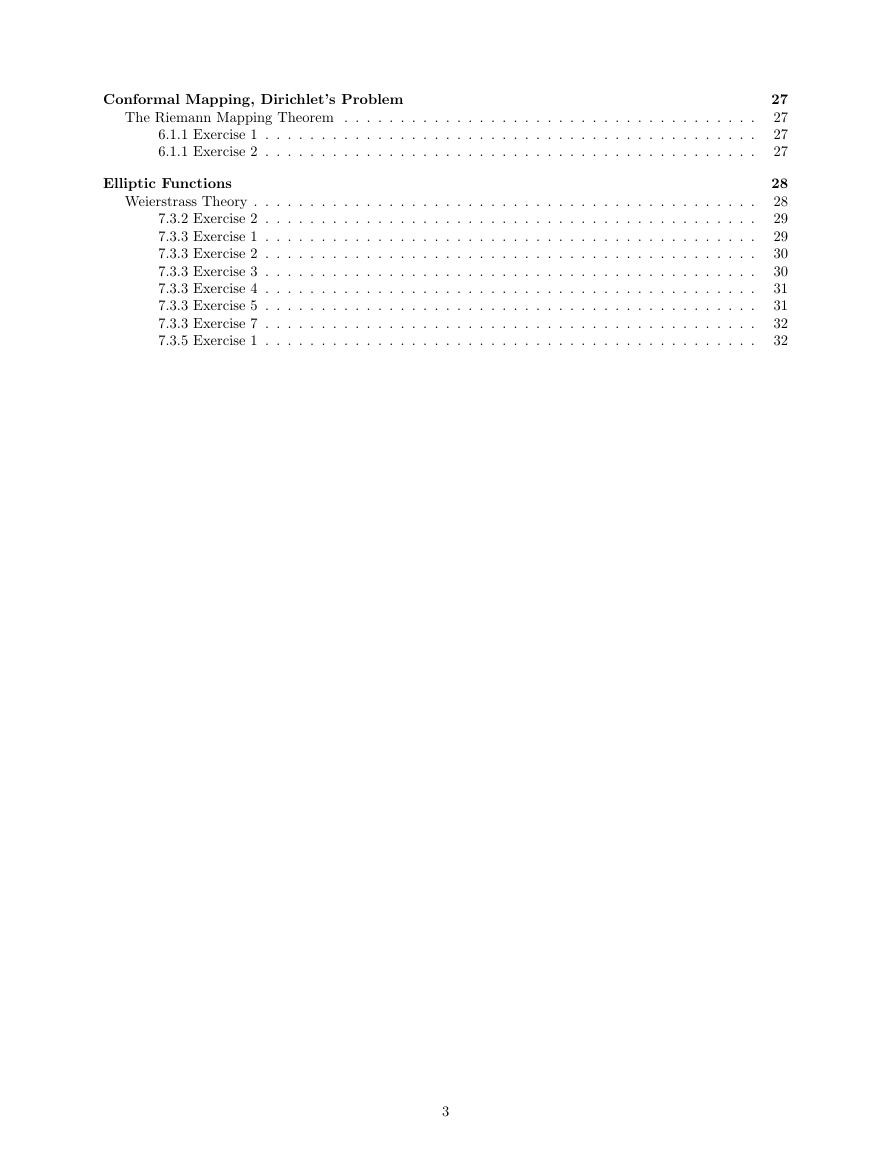
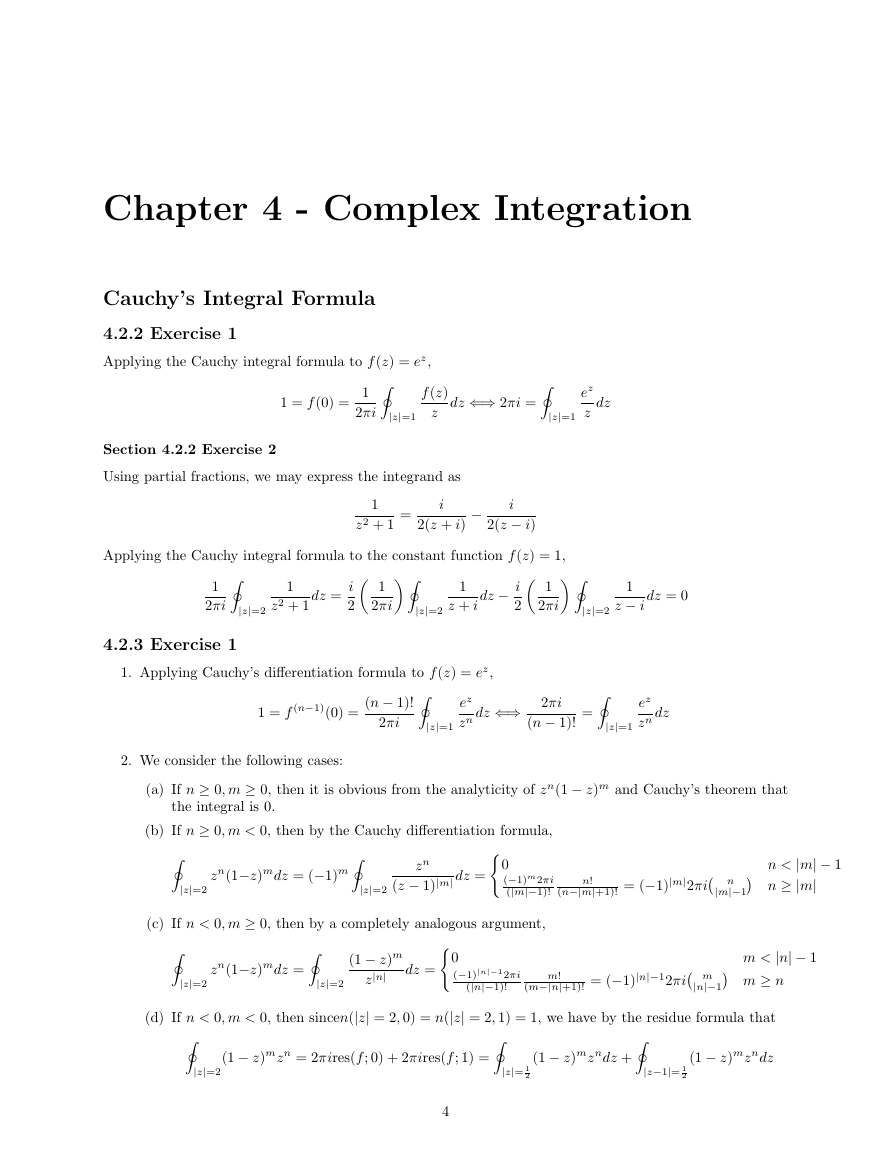
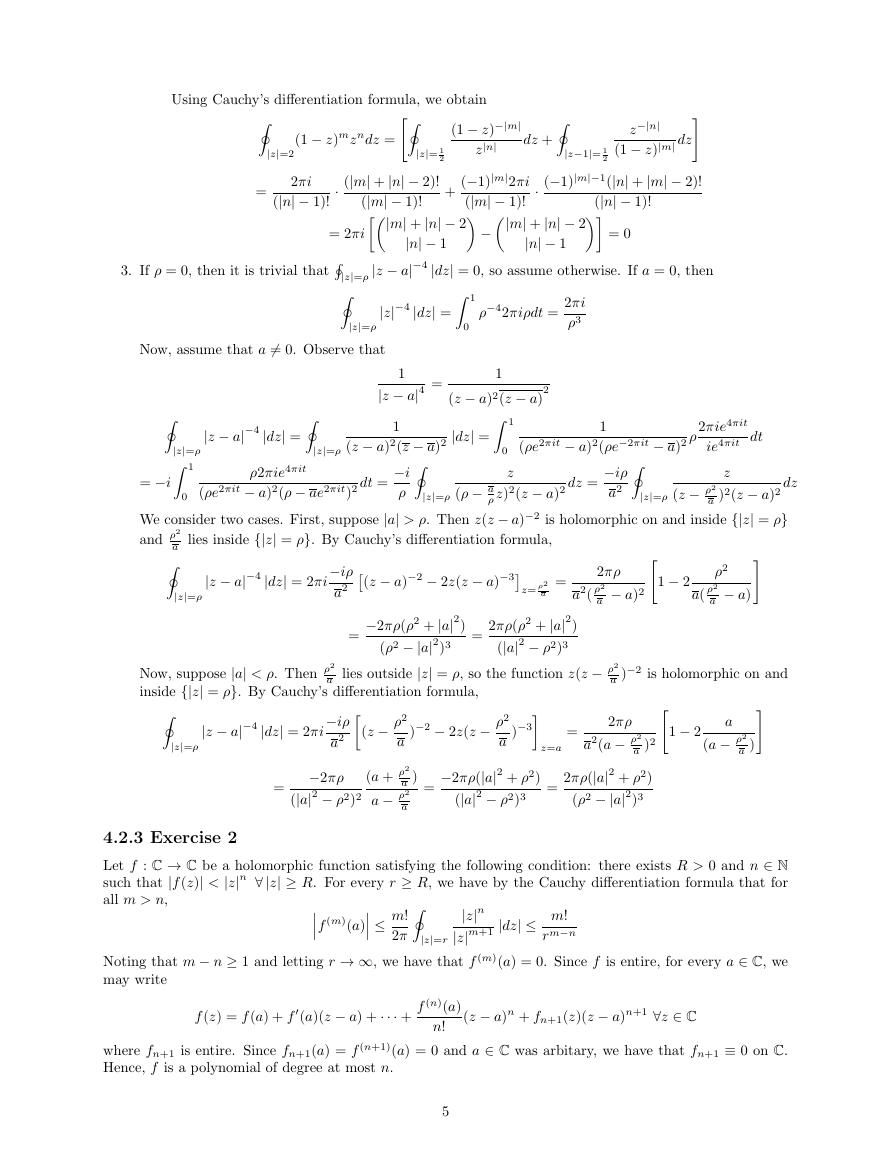
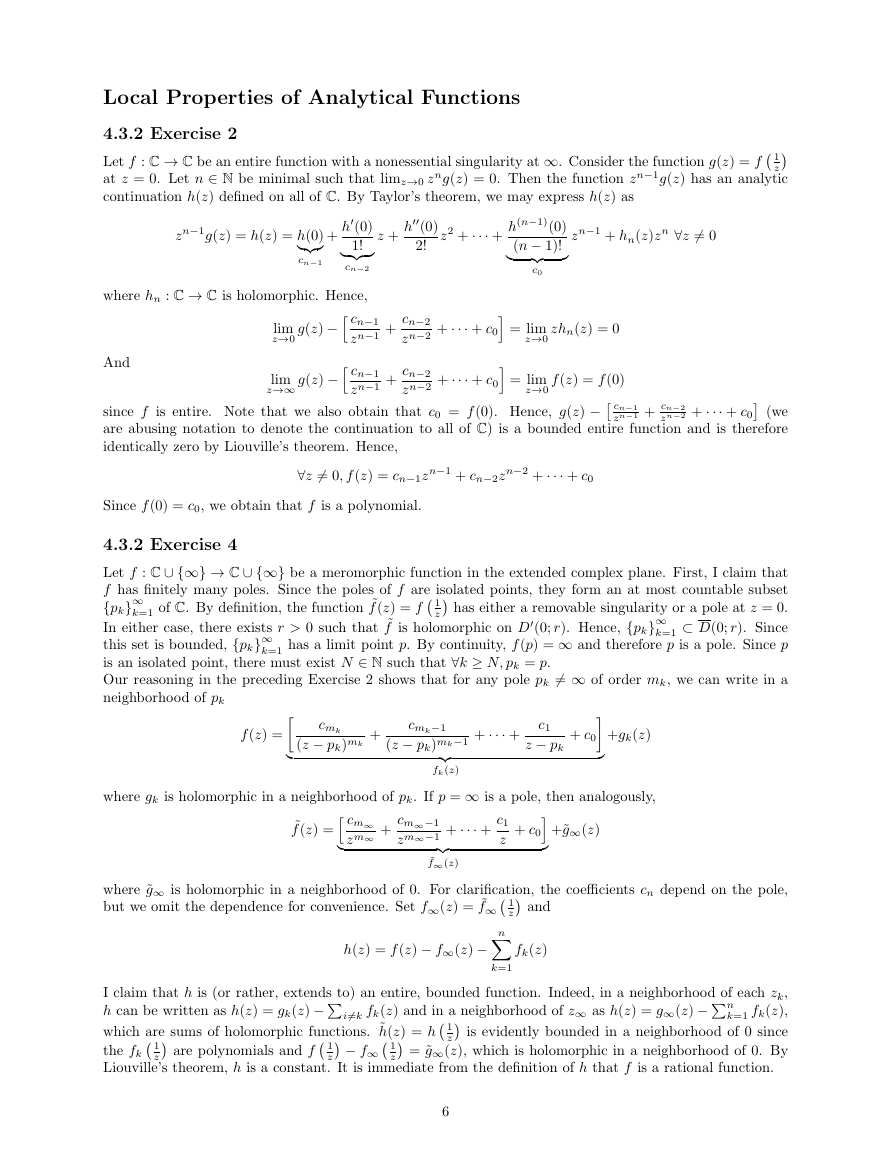
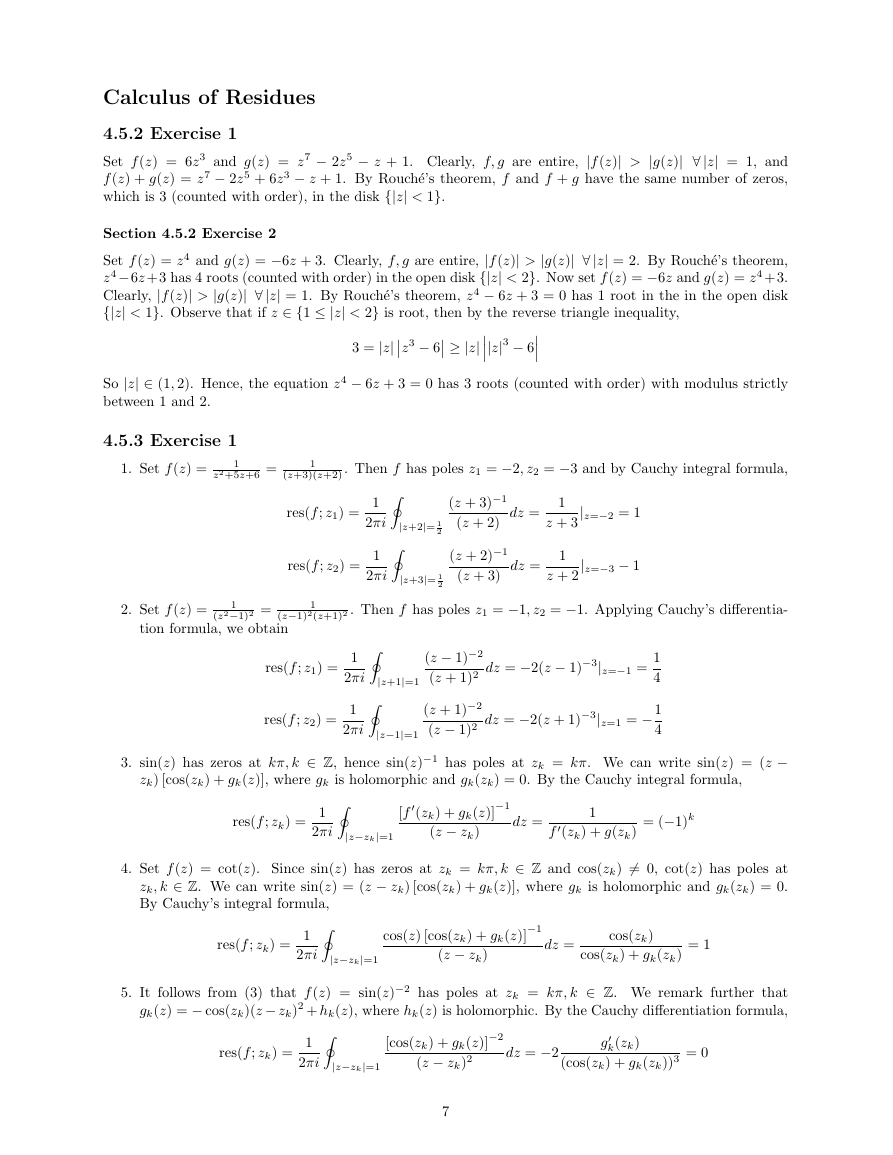
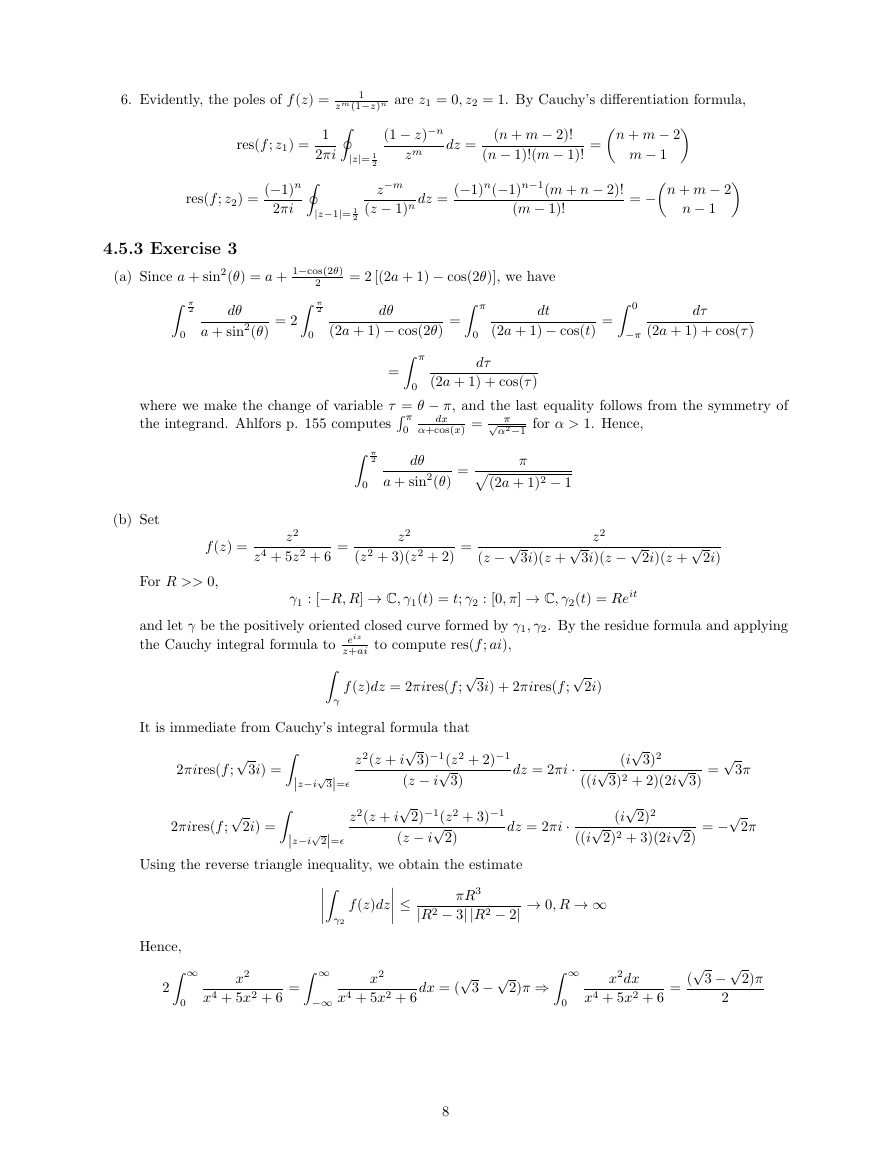








 2023年江西萍乡中考道德与法治真题及答案.doc
2023年江西萍乡中考道德与法治真题及答案.doc 2012年重庆南川中考生物真题及答案.doc
2012年重庆南川中考生物真题及答案.doc 2013年江西师范大学地理学综合及文艺理论基础考研真题.doc
2013年江西师范大学地理学综合及文艺理论基础考研真题.doc 2020年四川甘孜小升初语文真题及答案I卷.doc
2020年四川甘孜小升初语文真题及答案I卷.doc 2020年注册岩土工程师专业基础考试真题及答案.doc
2020年注册岩土工程师专业基础考试真题及答案.doc 2023-2024学年福建省厦门市九年级上学期数学月考试题及答案.doc
2023-2024学年福建省厦门市九年级上学期数学月考试题及答案.doc 2021-2022学年辽宁省沈阳市大东区九年级上学期语文期末试题及答案.doc
2021-2022学年辽宁省沈阳市大东区九年级上学期语文期末试题及答案.doc 2022-2023学年北京东城区初三第一学期物理期末试卷及答案.doc
2022-2023学年北京东城区初三第一学期物理期末试卷及答案.doc 2018上半年江西教师资格初中地理学科知识与教学能力真题及答案.doc
2018上半年江西教师资格初中地理学科知识与教学能力真题及答案.doc 2012年河北国家公务员申论考试真题及答案-省级.doc
2012年河北国家公务员申论考试真题及答案-省级.doc 2020-2021学年江苏省扬州市江都区邵樊片九年级上学期数学第一次质量检测试题及答案.doc
2020-2021学年江苏省扬州市江都区邵樊片九年级上学期数学第一次质量检测试题及答案.doc 2022下半年黑龙江教师资格证中学综合素质真题及答案.doc
2022下半年黑龙江教师资格证中学综合素质真题及答案.doc